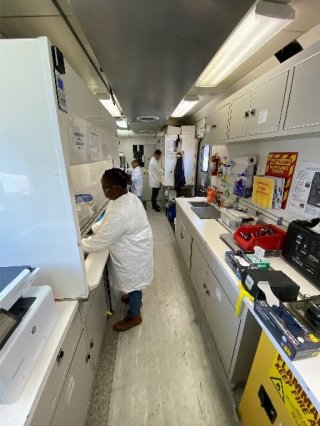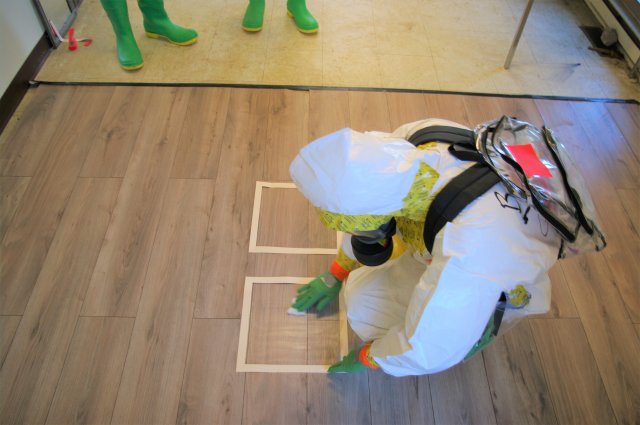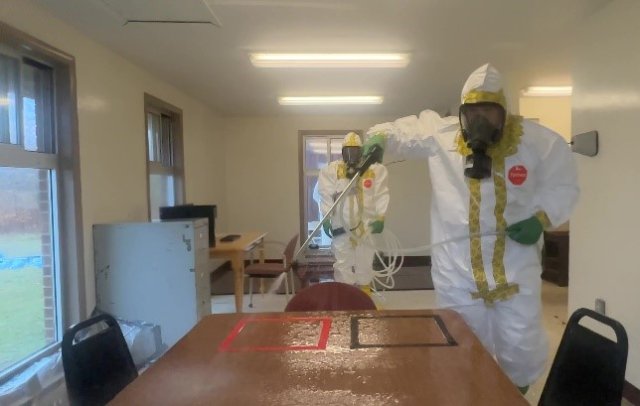Testing Chemical Agent Contamination Response in a Realistic Setting
Published January 23, 2024; Updated January 6, 2025

Chemical warfare agents (CWA), chemicals used to cause intentional death or harm through their toxic properties, remain a threat to the United States and other countries. EPA is enhancing the nation’s ability to respond to and recover from a potential chemical agent incident by developing environmental countermeasures and response exercises and trainings.
At the Operational Test and Evaluation of Chemical Remediation Activity (OTECRA), EPA researchers and emergency responders engaged in real-world scenario testing of an indoor chemical warfare agent release. The field study was held at the Muscatatuck Urban Training Center in Indiana. The interior of a building was configured to simulate two types of spaces: an office and a studio apartment. These rooms included common items that would need to be remediated in the event of a CWA incident, including wall materials, tables, IT equipment, countertops, and kitchen appliances.
The simulated scenario provided EPA responders and researchers an opportunity to understand the effectiveness of sampling and analytical methods and decontamination approaches. The field study and training exercise included an initial contamination event, followed by pre-decontamination sampling, decontamination, post-decontamination sampling, with waste management, and data management conducted throughout the exercise.
This exercise built upon a portfolio of research conducted at bench- and pilot-scale. The results informed surface wipe sampling methods, wet-vacuum sampling approaches, and the selection of different decontaminants.
The exercise allowed researchers to bring findings from studies together in a realistic setting along with assets and responder personnel throughout EPA. For example, EPA’s Portable High-throughput Integrated Laboratory Identification System (PHILIS) was integrated into the field study to analyze samples on-site, similarly to how it performs during emergency responses and removals. Air monitoring units were also set up for demonstration purposes to evaluate potential volatile hazards as they would be utilized during a real CWA release response. Readings were recorded on hand-held detectors currently being used in EPA Regions, allowing On-scene Coordinators (OSCs) to assess their effectiveness.
Contamination

To simulate a real-world scenario of a CWA release, a chemical simulant was applied to different surfaces inside the building. Malathion, an insecticide that is commonly used in place of organophosphorus CWAs (e.g., VX) in research studies, was applied as liquid droplets to hard and non-porous surfaces such as furniture and across the floor and walls. (Note: EPA received a categorical exclusion under NEPA for this field test since malathion is not authorized for indoor use.) The contaminated area was isolated and identified with caution tape, also known as the exclusion zone.
The level of contamination was measured using reference material coupons, polished rectangular stainless-steel surfaces that were placed in each room prior to contamination. After contamination, the coupons were retrieved and shipped to EPA’s laboratory in Research Triangle Park, NC, for analysis of relative contamination levels of malathion.
Pre- and Post-decontamination Sampling
The day after contamination, sampling teams conducted a pre-decontamination sampling to establish the concentration of malathion on surfaces. Effective pre-decontamination sampling characterizes the level of contamination and can help responders confidently plan and implement the remediation phase.
Sampling of non-porous surfaces, such as tables, floors, and walls was conducted with pre-wetted cotton gauze wipes and then analyzed on-site by PHILIS. This asset allows EPA the capability to evaluate samples immediately and provide next-day results for decision-makers. Larger floor samples were collected using a wet-vacuum approach. These samples were taken to the on-site processing location where they were packaged and shipped to an external commercial laboratory for analysis.
Researchers used EPA’s Environmental Sampling and Analytical Methods Program (ESAM) to identify best methods for analyzing the environmental and building material samples. This ensured a standardized process across all samples at each laboratory.
Once decontamination of the building interior was finished, sampling teams conducted post-decontamination sampling to establish whether any residual malathion remained on surfaces. A comparison of the pre- and post-decontamination sampling provided insight on whether the decontamination approach was successful.
Decontamination

Two rounds of testing were conducted during the field study to evaluate different decontamination approaches. For the first round, researchers applied Decon7, an activated hydrogen peroxide containing product, using a low-pressure spraying system. The second round of testing involved spraying undiluted bleach in a similar manner. The sprayers used during the exercise are commercially available and do not require extensive expertise or training to apply decontaminants.
Prior to leaving the exclusion zone, responders and equipment were decontaminated to minimize the potential for cross contamination and introduction of the contaminant to areas outside the exclusion zone. A contamination reduction zone was set up to decontaminate personnel, clothing, hand-held equipment, and samples. Responders walked through the line where diluted bleach was applied to all personnel protective equipment followed by a rinse off with water and patted dry. Samples coming out of the exclusion zone were wiped down with a bleach wipe.
Data Management
Samples throughout the exercise were closely managed with the use of a QR code attached to each sample container that could be quickly scanned in the field and lab. Using EPA’s Simple QUIck Read Label (SQUIREL) tool, researchers assigned a unique ID number to each sample. Researchers used electronic tablets to scan the ID and input information into ESRI’s Field Maps application on collection method, sample type, sample matrices, start and end times, observations, and photographs of the sample location. The data was then uploaded into EPA’s Geoplatform which generated a custom chain of custody form that was included in each sample shipment sent to the processing lab.
The data management team used portable Wi-Fi boxes that were critical to the functionality of these tools. Testing was conducted in an area with weak Wi-Fi signal, a likely occurrence in the event of a major disaster.

Waste Management
Proper management of waste from a CWA event is vital for the remediation process. Different decontamination strategies can result in various waste quantities and characteristics that will need to be managed, ultimately affecting the overall remediation timeline, resource requirement, and cost.
Prior to the exercise, EPA’s DeconST and I-WASTE tools were used to estimate the amount of materials likely to enter the waste stream from the contaminated facility both before and after decontamination, as well as additional waste material that was generated by personnel decontamination operations.
All waste generated during OTECRA was contained, segregated, and staged for characterization, sampling, and disposal by EPA’s Region 5, where the exercise was taking place. Information from sampling and analysis on how well the decontaminant performed was used to develop waste acceptance criteria and material disposal options, a requirement for CWA incidents. Waste material analysis was submitted for approval to disposal facilities in Ohio and Indiana.
Next Steps
The OTECRA team compiled lessons learned on what worked and what didn’t work during the field study. This information, as well as identification of operational and research gaps, are published in the report, "Operational Test and Evaluation of Chemical Remediation Activities". The Emergency Response Research Webinar series hosted a presentation on the OTECRA field study on August 14, 2024.
This full-scale study enhances the Nation’s ability to prepare for, respond to, and recover from a chemical agent incident by increasing responder confidence in the efficacy of sampling and decontamination methodologies, and through a sharpened operational perspective gained during the full-scale tests and evaluations. A strong collaboration between researchers and responders builds greater capability for the nation to respond to potential CWA events.
Read more:
Impact of Wipe Sampling Variables on Method Performance Associated with Indoor Pesticide Misuse
Wet-vacuum-based Surface Sampling Methods for Chemical Agents
Remediation Options for Porous Materials Contaminated with Persistent Chemical Warfare Agents
Efficacy and Compatibility of Decontamination Options for Sensitive Equipment-related Materials
Assessment of Decontamination Solution Application Methods for Decontamination of Surfaces
Water Rinses and their Impact on Decontamination Efficacies of Surfaces
